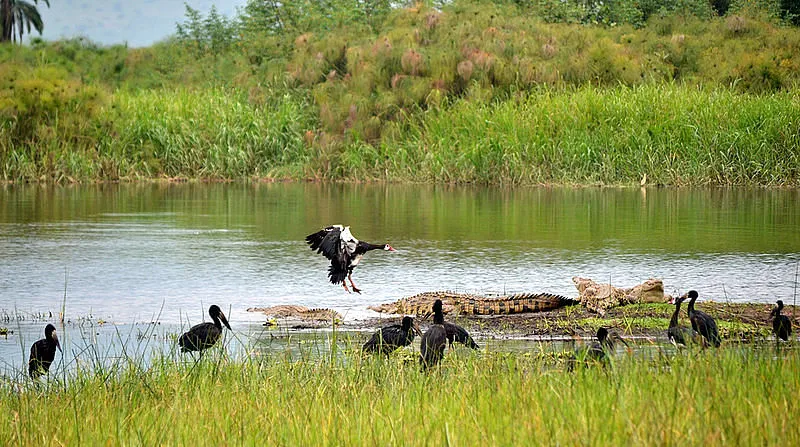Haya Qazi
The Earth has formed 4.6 billion years ago, and until the recent centuries, its evolution was more or less progressing naturally. About 2,00,000 years ago, the modern human, called the Homo sapiens appeared and was just another insignificant animal foraging the corners of Africa. Homo Sapien had other human relatives called Neanderthals, Homo Erectus etc., with whom it coexisted at one point in time. There was no way in which the Homo Sapien was superior to its relatives and the animals.
Just a matter of chance, the Homo sapiens got an intellectual edge over its relatives, discovered fire, learnt to communicate, and within a blip on the cosmic timeline, he set out to vanquish his less intelligent relatives and the splendid flora and fauna. Most people today have seen the ancient giant mammoths, ground sloths, elephant birds only in scientific shows or publications, some may not have even heard of them.
On the ascent to rule
When the Homo sapiens took to agriculture 12,000 years ago and started domesticating crops and animals, they spent lesser time worrying about food procurement. He now utilised his time to explore new ways of farming and invent more precise tools for hunting game. Agriculture steadily transformed hunter-gatherers into settlers. There was no going back! This Agricultural Revolution was followed by the Scientific Revolution in the 15th Century and the Industrial Revolution of the 18th Century which bought disruptive changes and transformed humankind permanently. By the end of the 20th century, Industry 4.0 was heralded. Eureka! The combination now made this animal invincible. Science meant progress. In India, for example, fewer people die due to hunger in 2022 than in 1922. Farmers can forecast weather, check soil fertility, locate fish stock in oceans, and generate and sell solar electricity from farms, all this leading to higher productivity and income generation. The Green Revolution of the 1960s saved the country from a disastrous famine, and India started producing more wheat and rice than ever before. Matter of fact, it now is an exporter of food grains.
Dr Frankenstein
Dr Frankenstein from the 1818 novel of Mary Shelly represents the dangers of enlightenment and the responsibilities that come with great knowledge. His scientific achievement becomes the cause of his downfall. The success of the Green revolution is attributed to Genetically Modified wheat, called High Yielding Varieties (HYV). The popularity of GM crops didn’t remain limited to wheat, now there are a number of genetically engineered crops in industrial agriculture, for example, corn, brinjal, cotton, potatoes, papaya etc. These may be exciting in short term, but what about the long-term effects? GM crops are not only a threat to human health but are also an ecological disaster. They can be detrimental to the insects and animals which are important to our ecosystem, and provide an ideal ground for invasive species, weediness, and higher toxins in the soil.
Today, plants and animals are mechanised, length and quality of their existence depend on the profits and losses of business corporations. The animals are mass produced in factory-like conditions, for example, the egg-laying hens have strong urges to forage and peck, build nests and groom themselves. But, they are caged with other hens where they can’t even flap their wings! Research shows that animals have complex emotional and social patterns, but the Homo sapiens won’t pay heed unless the animals’ psychology affects their milk, meat or egg production. Although technologies like bioengineering, eco-robotix and nanotechnology have made agriculture easy, they may also prove unethical if used with impunity. For instance, in 2000, a Brazilian scientist created a green fluorescent rabbit by using the DNA of green fluorescent jellyfish. Voila! A ridiculous work of art!
Ecological Apocalypse
From plants to animals to babies (designer babies), there isn’t a thing that Homo sapiens can’t interfere with. The clever human has altered nature to such an extent, that he will soon find himself in an inescapable catastrophe. Global Food Policy Report 2022 states that globally, around 65 million people are at risk due to climate change-induced hunger, with 17 million people in India facing hunger by 2030, the highest among all countries. Maize, wheat and coffee are some crops at high risk due to climate change. A new study published in Nature journal predicts a considerable decline in tomato production by 2050, climate change is now coming for your pizza sauce!
Closer home, saffron production has taken a hit in the past few years. Firstly, Homo sapiens’ drive to build concrete forests has changed cultivation and forest area into residential and commercial lands. Secondly, global warming has changed the snow and rain patterns, altering crop cultivation. Our reckless deforestation has rendered the animals homeless, it’s not uncommon to hear of bears and leopards devouring people. The gruesome murder of an elephant with a crude bomb in Kerela was just one incident that caught the limelight, humans kill animals in hundreds and such man-animal conflicts are bound to increase.
Rising sea levels, submerging islands, desertification, melting glaciers, forest fires, urban floods, greenhouse emissions, are some of the problems we know of. With the unmonitored use of technologies like AIML, bioengineering, and nanotechnology we will have graver problems to address.
Charles Dickens wrote about the French Revolution “this is the best of times, this is the worst of times.” This holds correct for the current era as well.
Disclaimer: The views and opinions expressed in this article are the personal opinions of the author. The facts, analysis, assumptions and perspective appearing in the article do not reflect the views of GK.






